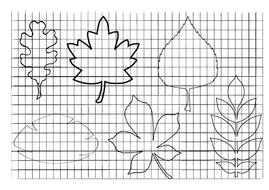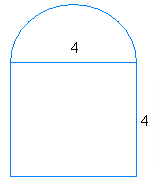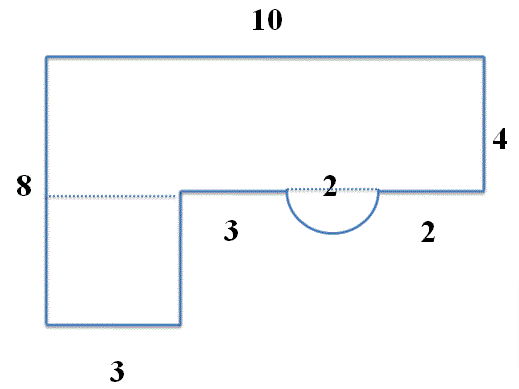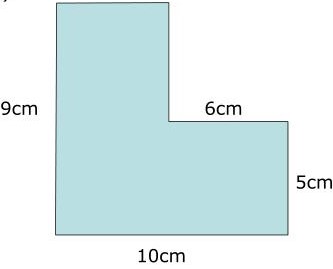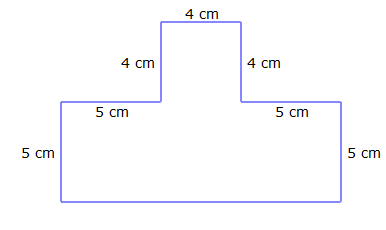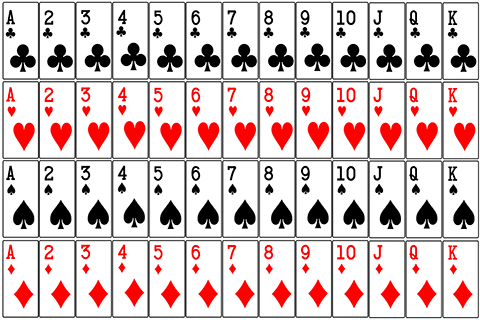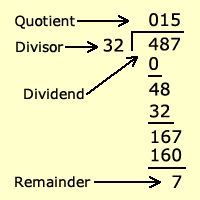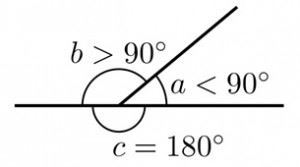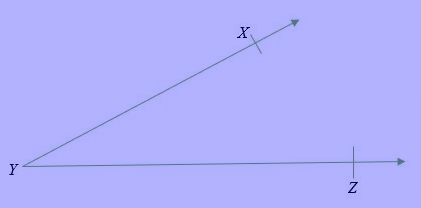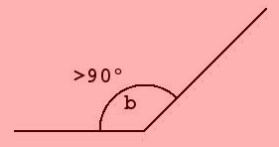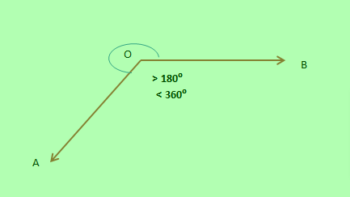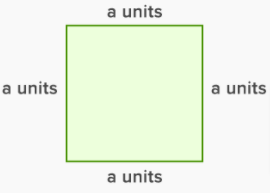Three-Dimensional Figures are shapes that consist of 3 dimensions such as length, breadth, and height. Three-Dimensional shapes also called solids. The length, breadth, and height are the three important measurements of 3-dimensional figures. There are different 3-dimensional shapes used in real-time. They are cuboids, cubes, Prisms, Pyramids, cylinders and cones, etc.
Solid Shapes
Solid shapes are the fixed objects they have fixed size, shape, and space. Let us check different examples of Solid Shapes to deeply understand the Solid Geometrical Figures.
Surface Area and Volume of Three-Dimensional shapes
Surface Area is defined as the complete area of the surface of the three-dimensional object. It is measured in square units. The surface area can be calculated using three different classifications.
- Curved Surface Area (CSA) is the area present in all the curved regions.
- Lateral Surface Area (LSA) is the area of all the flat surfaces and all the curved regions excluding base areas.
- Total Surface Area (TSA) is the area of all the surfaces including the base of a Three-Dimensional object.
The volume of the 3D shape is explained as the total space occupied by the three-dimensional object. It is measured in terms of cubic units and denoted by V.
Faces, Vertices, and Edges of a 3-Dimensional Shape
Have a look at the Faces, Vertices, and Edges of a 3-dimensional object.
- A solid consists of a flat part on it. Each flat part of a solid is known as the Face of a solid.
- The corner or Vertex is an end where three faces of a solid join together. Vertices are the plural form of the vertex.
- When two faces of a solid meet in a line called an Edge.
Types of Three Dimensional Shapes(3D Shapes)
Here we are going to discuss the list of three-dimensional shapes, their properties, and formulas. We even took examples for a better understanding of the concept.
1. Cuboid
A cuboid is also known as a rectangular prism consists of rectangle faces. The cuboid has 90 degrees angles each. Also, it has 8 vertices, 12 edges, 6 faces.
The formula of surface area and volume of a cuboid is given below.
Surface Area of a Cuboid = 2(lb + bh + lh) Square units
The volume of a Cuboid = lbh Cubic units
Examples of Cuboid are a box, a book, a matchbox, a brick, a tile, etc.,
Example:
Let us consider the below figure to completely understand a Cuboid
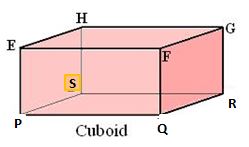
(i) Faces of a Cuboid: A cuboid consists of 6 faces. From the given figure, the 6 faces of the cuboid are PQRS, EFGH, PSHE, QRGF, PQFE, and SRGH.
(ii) Vertices of a Cuboid: A cuboid has 8 vertices. From the given figure, the 8 vertices of the cuboid are P, Q, R, S, E, F, G, H.
(iii) Edges of a Cuboid: A cuboid has 12 edges. From the given figure, the 12 edges of the cuboid are PQ, QR, RS, SP, EF, FG, GH, HE, PE, SH, QF, RG.
2. Cube
A Cube is of solid shape and consists of 6 square faces. The Cube all edges are equal. Also, it has 8 vertices, 12 edges, 6 faces.
The formula of surface area and volume of a Cube is given below.
Surface Area of a Cube = 6a² Square units
The volume of a Cube = a³ Cubic units
Example:
Let us consider the below figure to completely understand a Cube.
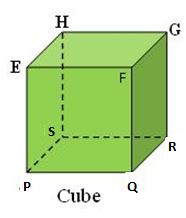
(i) Faces of a Cube: A cube consists of 6 faces. From the given figure, the 6 faces of the cube are PQRS, EFGH, PSHE, QRGF, PQFE, and SRGH.
(ii) Vertices of a Cube: A cube consists of 8 vertices. From the given figure, the 8 vertices of the cube are P, Q, R, S, E, F, G, H.
(iii) Edges of a Cube: A cube consists of 12 edges. From the given figure, the 12 edges of the cube are PQ, QR, RS, SP, EF, FG, GH, HE, PE, SH, QF, RG.
3. Prism
A prism has two equal ends, flat faces or surfaces, and also it has an identical cross-section across its length. If the cross-section of a prism looks like a triangle, then the prism is called a triangular prism. The prism will not have any curve. Also, it has 6 vertices, 9 edges, 5 faces (2 triangles and 3 rectangles).
The formula of surface area and volume of a Prism is given below.
Surface Area of a prism = 2(Base Area) + (Base perimeter × length) square units
The volume of a prism = Base Area × Height Cubic units
Example:
Let us consider the below figure to completely understand a triangular prism.
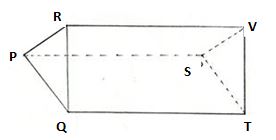
(i) Faces of a Triangular Prism: A triangular prism consists of 2 triangular faces and 3 rectangular faces. From the given figure, 2 triangular faces are ∆PQR and ∆STV, 3 rectangular faces are PQTS, PSVR, and RSTV.
(ii) Vertices of a Triangular Prism: A triangular prism consists of 6 vertices. From the given figure, the 6 vertices of the triangular prism are P, Q, R, S, T, V.
(iii) Edges of a Triangular Prism: A triangular prism consists of 9 edges. From the given figure, the 9 edges of the triangular prism are PQ, QR, RP, ST, TV, VS, PS, QT, RV.
4. Pyramid
A pyramid has a triangular face on the outside and its base is square, triangular, quadrilateral, or in the shape of any polygon. Also, it has 5 vertices, 8 edges, 5 faces.
The formula of surface area and volume of a Prism is given below.
Surface Area of a Pyramid = (Base area) + (1/2) × (Perimeter) × (Slant height) square units
The volume of a Pyramid = 1/ 3 × (Base Area) × height Cubic units
Example:
1. Let us consider the below figure to completely understand a Square Pyramid.

(i) Vertices of a Square Pyramid: A square pyramid consists of 5 vertices. From the given figure, OPQRS is a square pyramid having O, P, Q, R, S as its vertices.
(ii) Faces of a Square Pyramid: A square pyramid consists of faces one of which is a square face and the rest four are triangular faces. From the given figure, OPQRS is a square pyramid having PQRS as its square face and OPS, ORS, OQR, and OPQ as its triangular faces.
(iii) Edges of a Square Pyramid: A square pyramid consists of 8 edges. From the given figure, the square pyramid OPQRS has 8 edges, namely, PQ, QR, RS, SP, OP, OQ, OR, and OS.
2. Let us consider the below figure to completely understand a Rectangular Pyramid.
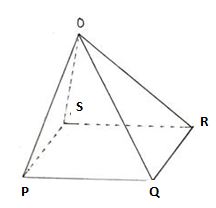
(i) Vertices of a Rectangular Pyramid: A Rectangular pyramid consists of 5 vertices. From the given figure, OPQRS is a Rectangular pyramid having O, P, Q, R, S as its vertices.
(ii) Faces of a Rectangular Pyramid: A Rectangular pyramid consists of 1 rectangular face and 4 triangular faces. From the given figure, OPQRS is a rectangular pyramid having PQRS as its rectangular face and OPS, OSR, OPQ, OQR as its triangular faces.
(iii) Edges of a Rectangular Pyramid: A rectangular pyramid consists of 8 edges. From the given figure, the rectangular pyramid OPQRS has 8 edges, namely, PQ, QR, RS, SP, OP, OQ, OR, and OS.
3. Let us consider the below figure to completely understand a triangular Pyramid.
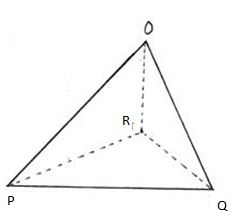
(i) Vertices of a triangular Pyramid: A triangular pyramid consists of 4 vertices. From the given figure, PQRS is a Rectangular pyramid having P, Q, R, S as its vertices.
(ii) Faces of a triangular Pyramid: A triangular pyramid consists of 4 triangular faces. From the given figure, PQRS is a rectangular pyramid having PQR, OPQ, OPR, and OQR triangular faces.
(iii) Edges of a triangular Pyramid: A triangular pyramid consists of 6 edges. From the given figure, the triangular pyramid PQRS has 6 edges, namely, OP, OQ, OR, PQ, PR, QR.
Cylinder
A cylinder is explained as a figure that has two circular bases connected by a curved surface. The cylinder will not consist of any vertices. Also, it has 1 curved face, 2 edges, 2 flat faces.
The formula of surface area and volume of a cylinder is given below.
Surface Area of a cylinder = 2πr(h +r) Square units
The curved surface of a cylinder = 2πrh Square units
The volume of a Cylinder = πr2 h Cubic units
Cone
A cone is defined as a three-dimensional figure, which has a circular base and has a single vertex. The cone decreases smoothly from the circular flat base to the top point. Also, it has 1 vertex, 1 edge, 1 flat face – circle, 1 curved face.
The formula of surface area and volume of a cylinder is given below.
Surface Area of a cone = πr(r +√(r²+h²) Square units
The curved surface of the area of a cone = πrl Square units
Slant height of a cone = √(r²+h²) Cubic units
The volume of a cone = ⅓ πr²h Cubic units
Sphere
A sphere appears round in shapes and every point on its surface is equidistant from the center point. The distance from the center to any point of the sphere is called the radius of the sphere. Also, it has No vertex, No edges, 1 curved face.
The formula of surface area and volume of a cylinder is given below.
The Curved Surface Area of a Sphere = 2πr² Square units
The Total Surface Area of a Sphere = 4πr² Square units
The volume of a Sphere = 4/3(πr³) cubic units
